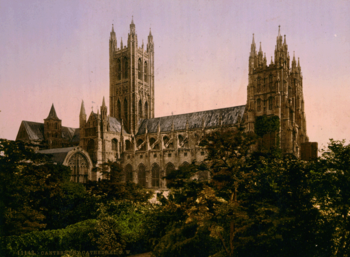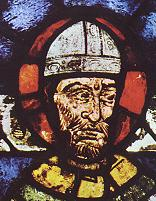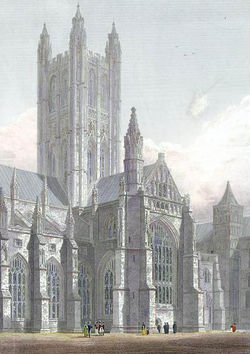Canterbury Cathedral
2007 Schools Wikipedia Selection. Related subjects: Architecture
Canterbury Cathedral is one of the oldest and most famous Christian structures in England. It is the Cathedral of the Anglican Archbishop of Canterbury, the Primate of All England and religious leader of the Church of England. As well as being the mother church of the Diocese of Canterbury (east Kent) it is the focus for the Anglican Communion. The formal title is the Cathedral and Metropolitical Church of Christ at Canterbury.
History
Augustine
The Cathedral's first Archbishop was St. Augustine, previously abbot of St. Andrew's Benedictine Abbey in Rome, sent to England by Pope Gregory the Great, arriving in AD 597.
St. Bede the Venerable (The Ecclesiastical History of the English People) records how the Cathedral was founded by St.Augustine, the first Archbishop. Archaeological investigations under the Nave floor in 1993 revealed the remains of this first Saxon Cathedral which had been built across a former Roman road by way of foundations. This church was dedicated to St. Saviour.
Augustine also directed the foundation of a Benedictine Abbey of Ss. Peter and Paul to be built outside the city walls. This was later rededicated to St. Augustine himself and was for many centuries the burial place of the successive archbishops. The remains are in the care of English Heritage and form part of the World Heritage Site along with the ancient Church of St. Martin, which appears to contain Roman work, although this is disputed.
The main subsequent phases of building are listed below (year ranges are the periods during which the relevant office was held):
Later Saxon and Viking
- Second building on same axis added by Archbishop Cuthbert ( 740- 760) as a baptistry and dedicated to St. John the Baptist.
- Oda ( 941- 958) renewed the building, greatly lengthening the Nave.
- The Cathedral community was reorganised as Benedictine Abbey during the reforms of Abp. St. Dunstan. St. Dunstan was buried on the south side of the High Altar.
- Lyfing ( 1013- 1020) and Aethelnoth ( 1020- 1038) added a western apse as an oratory of St. Mary.
Norman
- Lanfranc ( 1070- 1077),the first Norman archbishop, rebuilt the ruined Saxon church.
- St. Anselm greatly extended the Quire to the east to give sufficient space for the monks of the greatly revived monastery. The crypt of this church survives as the largest of its kind in England.
Thomas Becket
A dark chapter in the history of the Cathedral was the decapitation of Thomas Becket in the north-east Transept on Tuesday 29 December 1170 by guards that overheard King Henry II say "Who will rid me of this meddlesome priest?" when he was having troubles with Becket. The guards took it literally and murdered Becket in his own Cathedral. Becket was the second of four archbishops of Canterbury who were murdered (see also Alphege). Alphege's shrine was set on the north side of the High Altar.
- Following the disastrous fire of 1174 which destroyed the Eastern end, William of Sens rebuilt the Quire with a much more modern, Gothic design, including high pointed arches, flying buttressed, and rib vaulting, emphasizing vertical lines of tall pillars and spires to create greater interior heights. Later, William the Englishman added the Trinity Chapel as a shrine for the relics of St. Thomas the Martyr. Over time other significant burials took place in this area such as Edward Plantagenet (The ' Black Prince') and King Henry 4th. The Corona ('crown') Tower was built at the eastern end to contain the relic of the crown of St. Thomas's head which was struck off during his murder.
The income from pilgrims (including Geoffrey Chaucer's in " The Canterbury Tales") who visited Becket's shrine, which was regarded as a place of healing, largely paid for the subsequent rebuilding of the Cathedral and its associated buildings.
14th-16th centuries
- Prior Thomas Chillenden ( 1390- 1410) rebuilt the Nave in the Perpendicular style of English Gothic during his priorate.
- Lanfranc's original Norman central tower, the 'Angel Steeple', was demolished in the 1430s. Reconstruction took place over 50 years later, beginning in 1490, and completed in 1510, with a height of 297 feet. This new tower is known as the named 'Bell Harry Tower', after Prior Henry of Eastry who organised the work, and was onced called 'the finest tower in Christendom'. The bell still tolls 100 strokes, from about 8.55p.m. to sound the city's curfew.
Dissolution of the Monasteries
It ceased to be an abbey during the Dissolution of the Monasteries when all religious houses were suppressed. Canterbury surrendered in March 1539, the last abbey to do so and reverted to its previous status of 'a college of secular canons'.
18th century to Present
- The original Norman Northwest Tower was demolished in the late 1700s due to structural concerns, and was replaced during the 1830s with a Perpendicular style twin of the Southwest tower, currently known as the 'Arundel Tower'. This was the last major structural alteration to the cathedral to be made.
- The Romanesque monastic dormitory ruins were replaced with a Neo-Gothic Library and Archives building in the 19th Century. This building was later destroyed by a high-explosive bomb in the Second World War, which had been aimed at the Cathedral itself but missed by yards, and was rebuilt in similar style several years later.
Architectural plan of the present building
A curious bird's-eye view of Canterbury Cathedral and its annexed conventual buildings, taken about 1165, is preserved in the Great Psalter in the library of Trinity College, Cambridge. As elucidated by Professor Willis, it exhibits the plan of a great Benedictine monastery in the 12th century, and enables us to compare it with that of the 9th as seen at the abbey of Saint Gall. We see in both the same general principles of arrangement, which indeed belong to all Benedictine monasteries, enabling us to determine with precision the disposition of the various buildings, when little more than fragments of the walls exist. From some local reasons, however, the cloister and monastic buildings are placed on the north, instead, as is far more commonly the case, on the south of the church. There is also a separate chapter-house, which is wanting at St Gall.
The buildings at Canterbury, as at St Gall, form separate groups. The church forms the nucleus. In immediate contact with this, on the north side, lie the cloister and the group of buildings devoted to the monastic life. Outside of these, to the west and east, are the halls and chambers devoted to the exercise of hospitality, with which every monastery was provided, for the purpose of receiving as guests persons who visited it, whether clergy or laity, travellers, pilgrims or paupers.
To the north a large open court divides the monastic from the menial buildings, intentionally placed as remote as possible from the conventual buildings proper, the stables, granaries, barn, bakehouse, brewhouse, laundries, &c., inhabited by the lay servants of the establishment. At the greatest possible distance from the church, beyond the precinct of the convent, is the eleemosynary department. The almonry for the relief of the poor, with a great hall annexed, forms the paupers' hospitium.
The most important group of buildings is naturally that devoted to monastic life. This includes two Cloisters, the great cloister surrounded by the buildings essentially connected with the daily life of the monks,---the church to the south, the refectory or frater-house here as always on the side opposite to the church, and farthest removed from it, that no sound or smell of eating might penetrate its sacred precincts, to the east the dormitory, raised on a vaulted undercroft, and the chapter-house adjacent, and the lodgings of the cellarer to the west. To this officer was committed the provision of the monks' daily food, as well as that of the guests. He was, therefore, appropriately lodged in the immediate vicinity of the refectory and kitchen, and close to the guest-hall. A passage under the dormitory leads eastwards to the smaller or infirmary cloister, appropriated to the sick and infirm monks.
Eastward of this cloister extend the hall and chapel of the infirmary, resembling in form and arrangement the nave and chancel of an aisled church. Beneath the dormitory, looking out into the green court or herbarium, lies the "pisalis" or "calefactory," the common room of the monks. At its north-east corner access was given from the dormitory to the necessarium, a portentous edifice in the form of a Norman hall, 145 ft. long by 25 broad, containing fifty-five seats. It was, in common with all such offices in ancient monasteries, constructed with the most careful regard to cleanliness and health, a stream of water running through it from end to end.
A second smaller dormitory runs from east to west for the accommodation of the conventual officers, who were bound to sleep in the dormitory. Close to the refectory, but outside the cloisters, are the domestic offices connected with it: to the north, the kitchen, 47 ft. square, surmounted by a lofty pyramidal roof, and the kitchen court; to the west, the butteries, pantries, &c. The infirmary had a small kitchen of its own. Opposite the refectory door in the cloister are two lavatories, an invariable adjunct to a monastic dining-hall, at which the monks washed before and after taking food.
The buildings devoted to hospitality were divided into three groups. The prior's group "entered at the south-east angle of the green court, placed near the most sacred part of the cathedral, as befitting the distinguished ecclesiastics or nobility who were assigned to him." The cellarer's buildings were near the west end of the nave, in which ordinary visitors of the middle class were hospitably entertained. The inferior pilgrims and paupers were relegated to the north hall or almonry, just within the gate, as far as possible from the other two.
The Foundation
The Foundation is the authorised staffing establishment of the Cathedral, few of whom are clergy. The Head of the Cathedral is the Dean, currently the Very Rev'd Robert Willis, who is assisted by a Chapter of 24 Canons, four of whom are Residentiary, the others being honorary appointments of senior clergy in the diocese. There are also a number of Lay Canons who altogether form the Greater Chapter which has the legal responsibility both for the Cathedral itself and also for the formal election of an archbishop when there is a vacancy-in-see. By English law and custom they may only elect the person who has been nominated by the monarch on the advice of the Prime Minister. The foundation also includes the Kings's Scholars and a range of other officers, some of these posts are moridbund, such as that of the Cathedral Barber. The Cathedral has a full-time work force of 250 making it one of the largest employers in the district.




